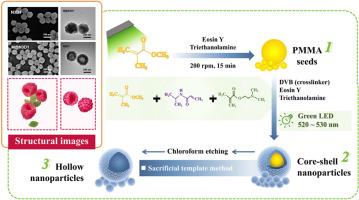Temperature and pH responsive raspberry-like hollow nanoparticles prepared by seed photopolymerization under green LED irradiation
IF 4.5
2区 化学
Q2 POLYMER SCIENCE
引用次数: 0
Abstract
Hollow polymer nanoparticles have garnered significant attention in sensing, catalysis, and biomedical applications due to their unique structural properties. To develop a novel synthetic approach of dual-responsive hollow nanoparticles, a visible-light-initiated photopolymerization strategy under green LED irradiation was established. First, monodisperse poly(methyl methacrylate) (PMMA) nanoparticles were synthesized via dispersion photopolymerization. These nanoparticles served as seeds for subsequent seed photopolymerization, enabling the formation of raspberry-like core-shell structures with different sizes and surface morphologies by adding different dosages of secondary stimuli-responsive monomers N-isopropylacrylamide (NIPAM) and 2-(dimethylamino)ethyl methacrylate (DMAEMA). Finally, solvent etching was employed to remove the PMMA seeds, producing hollow polymer nanoparticles with controllable temperature and pH responsiveness.

绿色LED照射下种子光聚合制备的树莓样中空纳米颗粒对温度和pH响应
由于其独特的结构特性,空心聚合物纳米颗粒在传感、催化和生物医学领域的应用受到了广泛的关注。为了开发一种新型的双响应中空纳米颗粒合成方法,在绿色LED照射下建立了可见光引发的光聚合策略。首先,采用分散光聚合法制备单分散聚甲基丙烯酸甲酯(PMMA)纳米颗粒。这些纳米粒子作为种子光聚合的种子,通过添加不同剂量的二次刺激响应单体n -异丙基丙烯酰胺(NIPAM)和2-(二甲氨基)甲基丙烯酸乙酯(DMAEMA),形成具有不同大小和表面形态的树莓状核壳结构。最后,采用溶剂蚀刻法去除PMMA粒子,得到温度可控、pH响应性可控的中空聚合物纳米颗粒。
本文章由计算机程序翻译,如有差异,请以英文原文为准。
求助全文
约1分钟内获得全文
求助全文
来源期刊

Polymer
化学-高分子科学
CiteScore
7.90
自引率
8.70%
发文量
959
审稿时长
32 days
期刊介绍:
Polymer is an interdisciplinary journal dedicated to publishing innovative and significant advances in Polymer Physics, Chemistry and Technology. We welcome submissions on polymer hybrids, nanocomposites, characterisation and self-assembly. Polymer also publishes work on the technological application of polymers in energy and optoelectronics.
The main scope is covered but not limited to the following core areas:
Polymer Materials
Nanocomposites and hybrid nanomaterials
Polymer blends, films, fibres, networks and porous materials
Physical Characterization
Characterisation, modelling and simulation* of molecular and materials properties in bulk, solution, and thin films
Polymer Engineering
Advanced multiscale processing methods
Polymer Synthesis, Modification and Self-assembly
Including designer polymer architectures, mechanisms and kinetics, and supramolecular polymerization
Technological Applications
Polymers for energy generation and storage
Polymer membranes for separation technology
Polymers for opto- and microelectronics.
 求助内容:
求助内容: 应助结果提醒方式:
应助结果提醒方式:


